Laptop Mag Verdict
This brushed aluminum machine balances good graphics performance with long battery life.
Pros
- +
Good endurance
- +
Sturdy brushed aluminum finish
- +
Above-average performance
- +
Over 6 hours of battery life
- +
Two-year warranty
Cons
- -
Mouse button a bit stiff
- -
Keyboard has some flex
- -
Lid picks up fingerprints
Why you can trust Laptop Mag
Last fall, ASUS released the UL80Vt, a 14-inch notebook that paired an ultra-low voltage processor with switchable graphics; in addition to 9 hours of battery life, users could also get some gaming in, too. The new UL80Jt-A1 ($869 as configured) still has switchable graphics, but now it comes with Nvidia's Optimus technology, which does the switching for you. ASUS also swapped the ultra-low voltage processor for an Intel Core i3 CPU, which delivers more power at the expense of battery life. Still, it's hard to argue with over 6 hours of endurance, making this brushed aluminum machine a solid choice for multimedia mavens.
Editor's note: Portions of this review were taken from the review of the ASUS UL80Vt.
Design
The UL80Jt-A1 is all black, with an attractive brushed metal lid. The deck is glossy plastic, while the bottom is matte plastic. This uniformity of color and design gives the system a sleek yet understated look, but tends to pick up fingerprints. In many ways, this notebook looks similar to the Samsung Q430-11, except the Samsung has a silver deck.
At 4.8 pounds and 13.5 x 9.6 x 1.1 inches, the UL80Jt-A1 is the same size and weight as the UL80Jv, which is to say it's not the thinnest and lightest 14-inch notebook on the block. However, it's nearly identical in weight and size to the Gateway ID49C, and 0.2 pounds lighter than the Samsung Q430-11. The overall feel is sturdy but this 14-inch laptop is still fairly portable.
Keyboard and Touchpad
The UL80Jt-A1's island style keyboard is spacious, and has its keys in all the proper positions, even if the right Shift key is a tad undersized. This notebook was certainly more comfortable to type on than the U33Jc, and we were up to our usual pecking speed in no time. However, compared to the Samsung Q430-11, this machine's layout exhibited more flex.
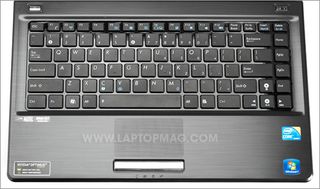
Click to enlarge
With a dotted surface that sits flush with and blends into the wrist rest, the UL80Jt-A1 touchpad certainly looks futuristic. Navigating around the desktop was pretty smooth. Too bad the single chrome mouse button felt stiff. We prefer two distinct buttons.
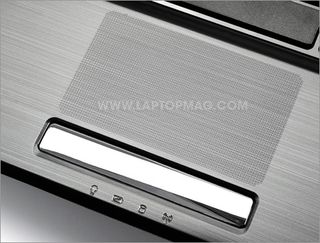
Click to enlarge
Ports and Webcam
The UL80Jt-A1 has all the ports you'd expect from a modern consumer notebook, including VGA, audio in/out, HDMI, Ethernet, and three USB connections. A 5-in-1 memory card reader is included for getting pictures or video off of your camera.

Click to enlarge

Click to enlarge
The 0.3-megapixel webcam provided smooth and fairly good quality video. Over Skype, a caller could make out the stripes on our shirt, although there was a little motion blur when we moved around.
Display and Sound
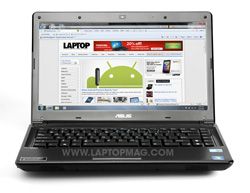
Click to enlarge
The 14.0-inch, 1366 x 768 glossy display on the UL80Jt-A1 provided bright, sharp images in our testing. While watching a DVD of Dark City and a 720p video stream of Fringe from Fox.com, playback was smooth, and colors were true with minimal noise and no pixelation. However, viewing angles leave something to be desired. At 45 degrees off center horizontally, color clarity is good enough when looking at the desktop, but when watching video, colors started to reverse and wash out, to say nothing of the reflections.
Sound quality from the front-mounted speakers was quite loud both when watching videos and listening to music. While listening to Alicia Keys' "If I Ain't Got You" on Pandora, the piano riff at the beginning came through mostly clear, but bass notes got a little lost and muddy when she started singing, and there was slight distortion in the higher tones when playing the song at full volume. Bass was completely lacking when playing Iron Maiden's "Run to the Hills," and the song came through tinny. For a 14-inch system, the UL80's speakers are above average, but the Toshiba Satellite M645's speakers are superior.
Performance
The UL80Jt-A1's 1.2-GHz Intel Core i3-330UM processor is a step up from the UL80Vt's 1.3-GHz Intel Core 2 Duo SU7300 CPU, which revealed itself in our testing. The UL80Jt scored 4,139 in PCMark Vantage, a 500-point increase over the UL80Vt, but about 300 points shy of the thin-and-light notebook average and about 1,300 points below the Gateway ID49C08u and Toshiba Satellite M645, both of which have 2.4-GHz Intel Core i5-540M CPUs. Still, the notebook had no problem multitasking, and windows popped open right away.
When converting a 114MB MPEG-4 into AVI format using HandBrake, the UL80Jt-A1 took 1 minute and 26 seconds, about 20 seconds slower than the average, but much better than the UL80Vt, which took 9:19. However, the Gateway ID49 and Toshiba M645 finished the test even faster: 54 and 52 seconds, respectively. The UL80Jt's 5,400-rpm, 500GB hard drive booted Windows 7 Home Premium in a slow 1 minute and 30 seconds, but otherwise was fairly fast, duplicating a 4.97GB folder of multimedia in 3 minutes and 2 seconds. That's a rate of 23.7 MBps, which is a bit higher than the category average of 23.9 MBps, the Gateway ID49 (25.7), and the Satellite M645 (21.2), but slower than the HP dm4 (30.3).
Graphics Performance
The UL80Jt-A1 features Nvidia's Optimus technology, which automatically switches between integrated and discrete graphics depending on the task at hand. When high performance is required, the discrete Nvidia 310M GPU with 1GB of memory kicks in. When it's not needed, the discrete graphics card powers down and the integrated Intel HD graphics take over to save battery life.
In 3DMark06, a benchmark that measures graphics performance, the UL80Jt-A1 scored 3,268, which is 200 points lower than the UL80Vt, but about 900 points higher than the thin-and-light notebook average. However, the 14-inch Gateway ID49 (7,230) and Toshiba M645 (6,113) scored much higher, both of which have Nvidia GT330M graphics (as well as Optimus technology).
While the UL80Jt-A1 is decent at gaming--it averaged 135 frames per second in World of Warcraft at a resolution of 1024 x 768--cranking things up to the max dropped that rate to 35 fps. That's still playable, but the Gateway ID notched 49 fps, and the M645 saw 55 fps. The Samsung Q430-11, which has the same GPU as the UL80Jt, but lacks Optimus, turned in similar scores to the UL80Jt-A1.
When playing Far Cry 2 at 1024 x 768-pixel resolution, the UL80Jt-A1 managed 21 fps, just below the category average. At its native resolution of 1366 x 768 and detail levels set at high, that number dropped to 14 fps, which isn't playable, but just above the 12 fps category average.
Even if you need to save power and use the Intel integrated graphics, you'll hardly notice the difference in everyday tasks. With integrated graphics on, we were able to zoom and scroll around Manhattan in Google Earth and play 720p video without a hitch.
Battery Life and Wi-Fi
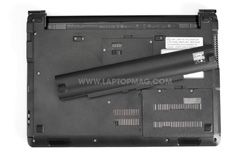
Click to enlarge
The UL80Jt lasted 6 hours and 14 minutes on the LAPTOP Battery Test (Web surfing via Wi-Fi). Although that runtime is three hours shorter than the UL80Vt, it's still an impressive 90 minutes longer than the category average, about 1:45 longer than the Gateway ID49, and 3 hours longer than the Samsung Q430-11.
The UL80Jt's Atheros AR9285 802.11b/g/n wireless card managed transfer rates of 35.9 Mbps and 25.2 Mbps from 15 and 50 feet, respectively. Both of these scores were well above the category averages of 29 and 21 Mbps.
Instant-On
If you just can't wait for Windows to boot and you need to get on the Web, view some photos, conduct a Skype chat, or listen to some tunes, the UL80Jt-A1 has ExpressGate, an instant-on operating system powered by Splashtop. By hitting the ExpressGate power button with the system off, you can get the instant-on splash screen in just a few seconds.
From the ExpressGate splash screen, you can choose which ExpressGate app you want to load: Chat, Music Player, Photo Manager, Skype, or Web Browser. While the Photo Manager and Music Player apps aren't bad for consuming media in a pinch, and the Skype/Chat options are serviceable, the main draw of ExpressGate is its browser, which is a version of Firefox.
In our tests, we got to the splash screen in 7 seconds, and then the browser in another 15. So, only 22 seconds after hitting the ExpressGate button, we were connected to our Wi-Fi network and surfing the Web.
Software and Support
The UL80Jt-A1 comes with 64-bit Windows 7 Home Premium installed, and is preloaded with CyberLink's Power2Go and LabelPrint for burning optical discs and creating labels. In addition, the system has a bevy of ASUS utilities, including ASUS MultiFrame for managing multiple monitors, ASUS Data Security for encrypting files and folders, and ASUS Smartlogon for facial recognition. Perhaps the most interesting utility is ASUS FancyStart, which lets you replace the ASUS logo that appears during the boot process with a custom image and sound.
The UL80Jt-A1 comes with a two-year global, one-year accidental warranty, and 24/7 toll-free phone support. See how ASUS fared in our annual Tech Support Showdown.
Verdict
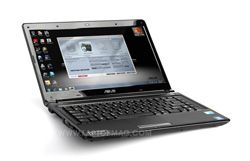
Click to enlarge
Of the numerous 14-inch Optimus notebooks we've reviewed so far, the ASUS UL80Jt stands out as one of the best. For $869, you get excellent endurance for a system this size without sacrificing too much performance. If you're looking for something with a little more graphics muscle, then the Gateway ID49C08u ($849) is the better option. But if all-day mobility trumps gaming prowess, then the UL80Jt is the way to go.
ASUS ul80jt Specs
| Brand | ASUS |
| CPU | 1.2-GHz Intel Core i3-330UM |
| Card Slots | 5-1 card reader |
| Company Website | www.asus.com |
| Display Size | 14 |
| Graphics Card | Intel GMA HD/Nvidia GeForce 310M |
| Hard Drive Size | 500GB |
| Hard Drive Speed | 5,400rpm |
| Hard Drive Type | SATA Hard Drive |
| Native Resolution | 1366x768 |
| Operating System | MS Windows 7 Home Premium (64-bit) |
| Optical Drive | DVD SuperMultiDrive |
| Optical Drive Speed | 8X |
| Ports (excluding USB) | Microphone, Headphone, HDMI, Ethernet, VGA |
| RAM | 4GB |
| RAM Upgradable to | 8GB |
| Size | 13.5 x 9.6 x 1.1 inches |
| Touchpad Size | 3 x 1.75 inches |
| USB Ports | 3 |
| Video Memory | 1GB |
| Warranty/Support | 2-year Parts and Labor, 1 year Accidental Damage, 30-day Zero Bright Dot Guarantee, 2-way free shipping, 24/7 Tech Support |
| Weight | 4.8 pounds |
| Wi-Fi | 802.11b/g/n |
| Wi-Fi Model | Atheros AR9285 |
